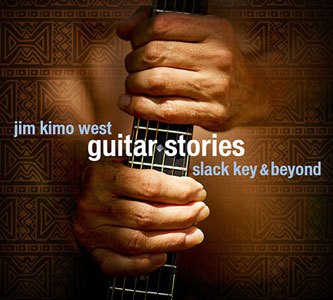 The
sound of Hawaiian slack key guitar is about as close to fretboard
heaven as you can get here on Earth. One guitarist who successfully
brings the time-honored Slack Key guitar sound into the 21st century
is California-based guitarist Jim “Kimo” West. In
2015, Jim released his latest masterpiece CD Guitar Stories
– Slack Key & Beyond on his Westernmost Records label.
The album features track by track liner notes by Jim, discussing the
origins and influences of certain tracks and the various guitar tunings
used on each song. The sound of Guitar Stories is very Hawaiian
influenced yet there’s also a harmonious chamber music / symphonic
sound featured throughout the album, especially on the lush sounding
“’Iolani Palace Waltz”—a
track that echoes ancient Celtic music and old English folk music—a
kind of instrumental madrigal, with the guitar featured as the main
instrument. In addition to his acoustic guitars, the CD also features
Jim’s baritone guitar, moog guitar and percussion. A number of
players assist, including string players: Simone Vitucci, Ben
Powell, Erik Rynnearson and Craig Eastman (strings),
along with Marty Rifkin (steel guitar) and a host of other
players. Some of the tracks are reminiscent of the famous Hawaiian
guitarist Kapono Beamer, but there’s plenty of original ideas
in play to help separate Jim from the wide range of Hawaiian music
guitar practitioners out there. Simply put, Jim “Kimo” West’s
Guitar Stores is one of the most beautiful sounding acoustic
guitar albums of the year. Guitar fans looking to explore the wonders
of Hawaiian style instrumental music need to listen to Guitar Stories.
www.JimKimoWest.com
The
sound of Hawaiian slack key guitar is about as close to fretboard
heaven as you can get here on Earth. One guitarist who successfully
brings the time-honored Slack Key guitar sound into the 21st century
is California-based guitarist Jim “Kimo” West. In
2015, Jim released his latest masterpiece CD Guitar Stories
– Slack Key & Beyond on his Westernmost Records label.
The album features track by track liner notes by Jim, discussing the
origins and influences of certain tracks and the various guitar tunings
used on each song. The sound of Guitar Stories is very Hawaiian
influenced yet there’s also a harmonious chamber music / symphonic
sound featured throughout the album, especially on the lush sounding
“’Iolani Palace Waltz”—a
track that echoes ancient Celtic music and old English folk music—a
kind of instrumental madrigal, with the guitar featured as the main
instrument. In addition to his acoustic guitars, the CD also features
Jim’s baritone guitar, moog guitar and percussion. A number of
players assist, including string players: Simone Vitucci, Ben
Powell, Erik Rynnearson and Craig Eastman (strings),
along with Marty Rifkin (steel guitar) and a host of other
players. Some of the tracks are reminiscent of the famous Hawaiian
guitarist Kapono Beamer, but there’s plenty of original ideas
in play to help separate Jim from the wide range of Hawaiian music
guitar practitioners out there. Simply put, Jim “Kimo” West’s
Guitar Stores is one of the most beautiful sounding acoustic
guitar albums of the year. Guitar fans looking to explore the wonders
of Hawaiian style instrumental music need to listen to Guitar Stories.
www.JimKimoWest.com
mwe3.com presents an interview
with
JIM KIMO WEST
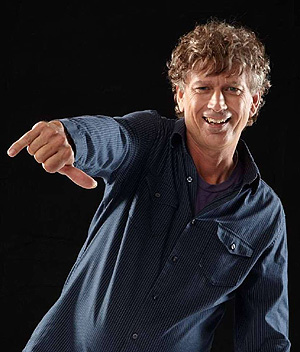 mwe3:
Can you tell the readers where you’re from originally and where
you live now and what you like best about it? What are some of your
favorite cities in the U.S. and also other countries to visit or perform
in?
mwe3:
Can you tell the readers where you’re from originally and where
you live now and what you like best about it? What are some of your
favorite cities in the U.S. and also other countries to visit or perform
in?
Jim Kimo West: I was born in Toronto, Canada and my family
moved to Florida when I was about nine. I started out playing guitar
professionally there when I was about 16, and in my late twenties
I moved to Los Angeles to further my career. The great climate and
wealth of musical possibilities that LA provided made it the perfect
place for me to live. I have played music in all fifty states and
most of Canada and much of Europe. I have a long relationship with
Hawaii so I’d have to say that’s my favorite place in the
world to spend time and perform, especially Maui and Kaua’i.
I do also enjoy going to new places. I was recently in Scandinavia
and I have to say, I do love that part of the world!
mwe3: When did you first pick up the guitar and can you remember
your first guitar? After playing and studying for a while what led
you to the sound of Hawaiian guitars and early on, who were some of
your choice guitar influences in Hawaiian music and how about favorite
current Hawaiian guitarists that you listen to?
Jim Kimo West: I was about twelve years old when I first took
my older brother’s neglected guitar out of the closet. It was
a no-name archtop with only three strings. My brother came from the
“folkie” era and when he saw my interest, he bought me new
strings, a capo and an instruction book. I immediately went to town
and learned a few chords and even “wrote” my first tune
the next day. I still remember it! I listed to his folk records and
learned finger picking, which has been an important element in my
playing style today. My parents then bought me a 12 string, which
I loved and eventually a solid body electric. My first real electric
setup was a Fender Tele and a Bassman amp-not too shabby!
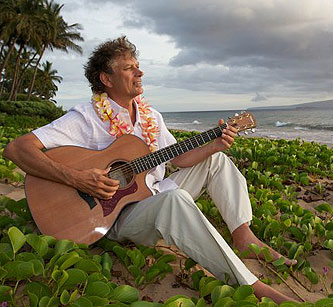 As I got
more into heavier rock, I traded those in for a Les Paul and Marshall
amp when I was about sixteen. After to moving to LA in the early 80’s
I was invited to join a friend on a trip to Hana, Maui - a very small
rural town and one of the most Hawaiian areas in the state. I fell
in love with the place and heard “slack key” guitar for
the first time on LPs and cassettes there where we stayed. It was
an enchanting sound that seemed to be deeply connected to the physical
environment and since I had some experience with open tunings, it
was a style I could understand from the technical standpoint.
As I got
more into heavier rock, I traded those in for a Les Paul and Marshall
amp when I was about sixteen. After to moving to LA in the early 80’s
I was invited to join a friend on a trip to Hana, Maui - a very small
rural town and one of the most Hawaiian areas in the state. I fell
in love with the place and heard “slack key” guitar for
the first time on LPs and cassettes there where we stayed. It was
an enchanting sound that seemed to be deeply connected to the physical
environment and since I had some experience with open tunings, it
was a style I could understand from the technical standpoint.
The first slack key record I heard was one by Gabby Pahinui, the most
legendary of all slack key artists. He brought slack key from the
back porch to the public stage with his recording of “Hi’ilawe”
in 1946. His records were “chicken skin” as they say (goosebumps
), and his voice seemed to be channeling ancient Hawaiian chants.
I also fell in love with records by legends such as Sonny Chillingworth,
Atta Isaacs, Raymond Kane and Leonard Kwan. Once I started playing
slack key I discovered the newer (at that time) generation of players:
Keola Beamer, Ozzie Kotani, Ledward Kaapana etc. through the great
Dancing Cat record series that George Winston put out. The great thing
about these records was the inclusion of very thorough documentation,
which helped me discover many great tunings.
mwe3: How many different guitars are you playing on Guitar
Stories. What are are some of your current favorite guitars including
the electric guitar and how did you become involved with the moog
guitar and the acoustic Baritone guitars?
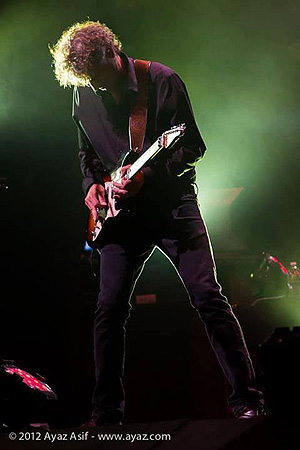 Jim Kimo
West: I use a number of acoustic guitars on this record. My main
axe for fingerstyle is a Taylor 514 CE which is a mahogany / cedar
construction and then I also used anther Taylor 814 LTD which is Brazilian
rosewood and spruce, most for strumming. I also used a 1970 Martin
D-18, which is a guitar that needs no EQ at all-it just sounds perfect
as is! Then I made much use of a Tacoma Thunderchief baritone acoustic,
which is amazing. That guitar is not made any more unfortunately -
it sounds great and plays very well. When you put that guitar in an
open tuning the lowest string can be an A, which really moves some
air!
Jim Kimo
West: I use a number of acoustic guitars on this record. My main
axe for fingerstyle is a Taylor 514 CE which is a mahogany / cedar
construction and then I also used anther Taylor 814 LTD which is Brazilian
rosewood and spruce, most for strumming. I also used a 1970 Martin
D-18, which is a guitar that needs no EQ at all-it just sounds perfect
as is! Then I made much use of a Tacoma Thunderchief baritone acoustic,
which is amazing. That guitar is not made any more unfortunately -
it sounds great and plays very well. When you put that guitar in an
open tuning the lowest string can be an A, which really moves some
air!
I discovered the Moog guitar a number of years ago and it has been
used on a lot of recordings in places where I want a “pad”
type of sound. Rather than use a synthesizer, it gives me a more organic
way of achieving that with guitar. It essentially is an electromagnetic
guitar that can sustain notes and chords indefinitely by applying
a variable amount of magnetism to the strings while you play. It is
otherworldly and very inspiring!
There isn’t much electric guitar on the record but my electrics
of choice are two Tom Anderson guitars, one a Strat- style and one
a Tele- style. I also like my old Silvertone solid body with DeArmond
pickups. I have a number of amps I use but tend towards using my Fractal
Axe FX II for electric sounds. I also use this unit on tour with Weird
Al.
mwe3: What is your background in other genres of music? In
addition to Hawaiian music, what other styles and genres of guitar
music influenced you early on including rock, jazz and classical guitar
music? Who are some of your favorite rock, classical and jazz guitarists?
Jim Kimo West: I started playing in rock bands when I was sixteen
so that is a huge part of my musical background. I still love to rock
and I get to do that a lot in my regular gig as guitarist for “Weird
Al” Yankovic. I am totally self-taught. I have a perfect record-no
lessons or music classes at all! I bought books, taught myself to
read, learned music from my more schooled band mates and listened
to a lot of records! In the early ‘90s I had a unique chance
to study orchestration due to a job I got for 20th Century Fox. China
had bought a number of classic Fox films to distribute there but they
needed to be dubbed into Chinese. Since most of the original elements
were lost, whenever there was dialog the music and sound effects had
to be replaced. Using a cheap sampler I hand-played all the parts
of the original score to create a seamless transition from the original.
There were thirteen films with scores by many famous composers like
Bernard Hermann and Alfred Neuman so I essentially learned orchestration
from them by taking apart their scores!
 I
started getting into jazz just before my introduction to Hawaiian
music. I didn't really learn a lot of standards and all but I was
really hungry to learn the harmonic concepts of jazz, which I love
to employ from time to time. That being said, I’ve never had
a legit jazz gig but who knows, maybe one day… I did learn a
few classical pieces when I was teaching myself to read but I realized
early on that this course of study was pretty intense and there were
far fewer girls interested in classical guitarists! I have so many
favorite guitarists but if were to name just a few I’d say Jimi
Hendrix, Lenny Breau, Paco DeLucia and Michael Hedges were all great
innovators in their respective idioms.
I
started getting into jazz just before my introduction to Hawaiian
music. I didn't really learn a lot of standards and all but I was
really hungry to learn the harmonic concepts of jazz, which I love
to employ from time to time. That being said, I’ve never had
a legit jazz gig but who knows, maybe one day… I did learn a
few classical pieces when I was teaching myself to read but I realized
early on that this course of study was pretty intense and there were
far fewer girls interested in classical guitarists! I have so many
favorite guitarists but if were to name just a few I’d say Jimi
Hendrix, Lenny Breau, Paco DeLucia and Michael Hedges were all great
innovators in their respective idioms.
mwe3: Is Guitar Stories a different type of album for
you in that, in addition to the Hawaiian guitar sounds you also mix
in Spanish music and even West African music? After hearing Guitar
Stories, it sounds like you take to other genres of guitar music
very naturally and effectively.
Jim Kimo West: Well thank you! I really was ready to present
another side of myself with this record. I do love Hawaiian slack
key guitar but I have explored that genre for quite a while and I
had so many other ideas to expand on. I had so much fun doing that,
and I’m ready to do more musical exploration soon!
mwe3: How do you write music in general? Because you use so
many different guitar tunings on Guitar Stories, do you choose
the tunings first or does the song or composition determine the tuning?
Is melody the most important element in your music or do you go after
a certain sound dynamic or arrangement? I say that because track six
on Guitar Stories – “’Iolani Palace Waltz”
has such a great melody and arrangement. Is that one of the most beautiful
tracks you’ve done yet?
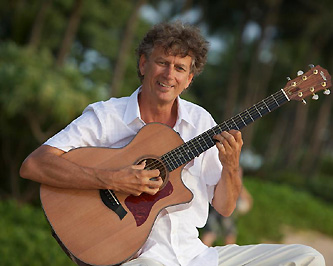 Jim Kimo
West: I have been directly inspired to write many songs by the
simple discovery of a new tuning. I find having a completely different
harmonic palette under you fingers is very inspiring. It’s like
your ear is leading rather than your fingers, as your existing chord
and finger position knowledge doesn't apply anymore.
Jim Kimo
West: I have been directly inspired to write many songs by the
simple discovery of a new tuning. I find having a completely different
harmonic palette under you fingers is very inspiring. It’s like
your ear is leading rather than your fingers, as your existing chord
and finger position knowledge doesn't apply anymore.
I do like to improvise and try different techniques… sometimes
ideas just seem to spring up in that process. I have written pieces
like “My Hawaiian Heart” in twenty minutes, which always
blows my mind! I do love melody and I tend to sing along with the
guitar part as I am developing it as that helps me create a more memorable
tune. If a melody is singable, it tends to have more staying power,
I believe.
When I travel I always have a guitar with me and at least, a small
handheld recorder. When I come up with something I like, I record
it immediately so as to not forget it. Then I transfer my musical
ideas to my laptop where I then go through them, delete some and categorize
the others. Guitar Stories was partly a result of expanding
on some of these stored ideas.
mwe3: Are certain guitars better for different tunings than
others? Does the different tuning at all affect or put undo stress
on the guitar itself? Does retuning or detuning a guitar affect the
wood or strings and what are your favorite tunings to play? I was
very interested in the Anuenue tuning, on the beautiful sounding “Mauna
Kea Meditation”, a track which is truly sublime sounding.
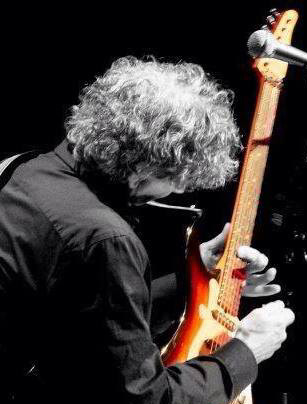 Jim Kimo
West: I am usually de-tuning strings but in some cases I am raising
a string a whole step or even a minor third. I use light gauge so
that’s not too much of an issue. In the case of lowering strings
a lot, I might switch to a medium gauge for that. Or if it needs to
be even lower I will use the baritone.
Jim Kimo
West: I am usually de-tuning strings but in some cases I am raising
a string a whole step or even a minor third. I use light gauge so
that’s not too much of an issue. In the case of lowering strings
a lot, I might switch to a medium gauge for that. Or if it needs to
be even lower I will use the baritone.
Sometime a certain amount of “floppiness” in the strings
can be great for getting more vibrato and expression - it’s a
little more “rock” and great for single note lines. Many
electric players detuned, Hendrix for example, and used very light
strings like .008’s for a very big vibrato and ease of playing.
The Anuenue tuning is one I developed when I was recording my first
CD, Coconut Hat, on which I used it for a few tunes including
“ Cereus”. It is essentially a major 6 + 9 tuning. It has
very close voicing in the string pitches so one can get very dense
chords similar to what one can get on a keyboard. It is: D A D F#
A B, low to high. The highest two strings are usually replaced with
slightly heavier gauges.
mwe3: Another standout track on Guitar Stories is “Daydream
At Jumbo Rocks”. How does the Joshua Tree National Park inspire
you and tell us something about the Mahoe tuning? That track is so
unique sounding and also can you tell us how you met Marty Rifkin,
who adds in steel guitar?
Jim Kimo West: Joshua Tree National Park is an amazing place.
I used to go there a lot and it’s hard to believe that such a
place exists two or so hours from LA. The air is so clear and the
landscape is just surreal with impossible rock formations and unusual
cacti, and the night sky is incredible. It is definitely a place that
inspires many.
The Mahoe tuning is another one of mine that I used starting with
my first CD. “Mahoe” means “twins” in Hawaiian
language and this tuning has two strings with the same pitch. Besides
the obvious “drone” sound it allows some interesting voicings
as a one fret difference between the two adjoining unison strings
creates a minor second, not always easy to get in standard tuning.
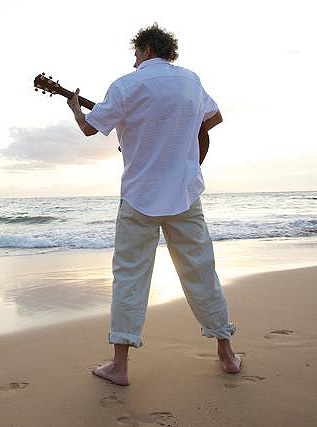 I met Marty
Rifkin many years ago when I was producing demos and tracks for independent
artists. He was hired to play pedal steel on a country project and
we have been friends ever since. He has played on a few “Weird
Al” tracks as well. He played a non-pedal Fender lap steel on
this track and quite beautifully, I might add. Marty has played with
so many legends such as Springsteen, Dwight Yoakum, many others and
sometimes joins me at my live shows.
I met Marty
Rifkin many years ago when I was producing demos and tracks for independent
artists. He was hired to play pedal steel on a country project and
we have been friends ever since. He has played on a few “Weird
Al” tracks as well. He played a non-pedal Fender lap steel on
this track and quite beautifully, I might add. Marty has played with
so many legends such as Springsteen, Dwight Yoakum, many others and
sometimes joins me at my live shows.
mwe3: Tell us where Guitar Stories was recorded. Do
you get to record and write music in Hawaii a lot or do you mostly
work on the west coast? What’s new and interesting in Hawaii
for you these days? You must be an expert on the Islands as many of
the tracks on Guitar Stories are dedicated to elements of scenic
wonder in Hawaii.
Jim Kimo West: I have been recording and engineering almost
as long as I have been playing guitar. Actually I think started playing
with tape recorders before I started playing guitar. I have always
had a personal home studio so all my records are recorded there in
Los Angeles. It’s quite well equipped with nice preamps and outboard
gear and is based around a Mac Pro set up. When I travel I also carry
a small portable set up with a Mac laptop, interface and two microphones
so I do record in hotel rooms when I have to. I believe the main guitar
part in “Iolani Palace Waltz” was recorded in a hotel room
actually.
I have been going to Hawaii for over thirty years now and have seen
many changes. The one that is most obvious is the shift of land ownership
towards wealthy vacation homeowners and away from the local populace
who are being priced out of their own homeland. There is also a very
visible Hawaiian sovereignty movement now. It is a much delayed response
to the illegal annexation of Hawaii, which was a sovereign nation,
in the 1800’s by what was essentially a consortium of wealthy
and powerful businessmen. Perhaps one day I will be able to apply
for a Hawaiian passport!
Hawaii has been a lifelong inspiration for me. I have got to know
many beautiful areas very well and sometimes I have to pinch myself
when I walk those pristine beaches and hike the primeval forests.
Hawaii is a very isolated speck in a huge ocean so one’s perspective
is very much expansive and spatial in a way, I guess. Just as Hawaiian
folk music is an extension of the “aina” or physical environment,
I would say my own slack key compositions are directly inspired by
the places and people I know in Hawaii.
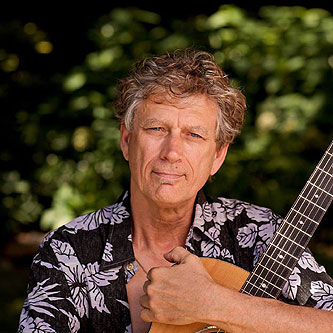 mwe3:
What is it like working in the band of “Weird Al” Yankovic
and are you still working with him? Have you done albums with Weird
Al as well or only appear on tour?
mwe3:
What is it like working in the band of “Weird Al” Yankovic
and are you still working with him? Have you done albums with Weird
Al as well or only appear on tour?
Jim Kimo West: Playing with Al is great fun and quite musically
challenging as well. We cover a multitude of styles from polka to
dubstep! It is a thrill to play for big crowds and to exercise my
rock and roll chops, to travel to new and exciting places and meet
lot’s of people. Besides all that, Al is a very nice guy and
a joy to work for.
Yes, I play on all the records. On the first two records, our then-
producer, Ric Derringer played most of the solos but it’s been
all me since then. Besides guitar I also do a lot of the MIDI and
synth production and programming on the CD’s - something I have
learned to do from many years working as a composer for film and TV
and doing record production.
mwe3: I know Guitar Stories just came out but, have
you had any time yet to consider what directions you might be wanting
to go in next as far as writing and recording and future concerts
in 2016?
Jim Kimo West: I have a few projects in the works. One is going
to be another slack key record but one with a modern ambient, almost
dreamy feeling. I also have a record in the works with slack and steel
guitar master, Ken Emerson, as well as a collaboration with a fantastic
group of players in Singapore and India. All very exciting stuff.
Then of course there will be Guitar Stories, Vol II !
 On
January 17 I will be playing the So Cal Slack Key Festival in Redondo
Beach, California. There I will be doing some duets with Jeff Peterson,
a fabulous player from Hawaii. I also will be opening for Muriel Anderson
at Ruth B. Shannon Center at Whittier College on January 20. I plan
to do a series of shows with Ken Emerson in March then head to Hawaii
in May for some gigs. Beginning mid-June I will be back on the Mandatory
World Tour with “Weird Al” again.
On
January 17 I will be playing the So Cal Slack Key Festival in Redondo
Beach, California. There I will be doing some duets with Jeff Peterson,
a fabulous player from Hawaii. I also will be opening for Muriel Anderson
at Ruth B. Shannon Center at Whittier College on January 20. I plan
to do a series of shows with Ken Emerson in March then head to Hawaii
in May for some gigs. Beginning mid-June I will be back on the Mandatory
World Tour with “Weird Al” again.



